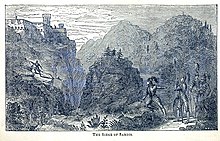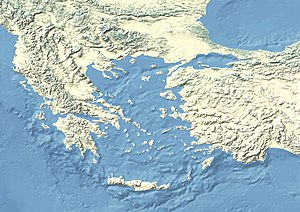Siege of Sardis (547 BC)
| Siege of Sardis (547 BC) | |||||||||
|---|---|---|---|---|---|---|---|---|---|
| Part of the Campaigns of Cyrus the Great | |||||||||
 Remains of the acropolis of Sardis, where Croesus was finally captured[1] | |||||||||
| |||||||||
| Belligerents | |||||||||
| Lydian Empire |
Achaemenid Empire | ||||||||
| Commanders and leaders | |||||||||
|
Croesus, unknown others |
Cyrus the Great, Harpagus, unknown others | ||||||||
| Strength | |||||||||
| 100,000 (Herodotus) | 200,000 (Herodotus) | ||||||||
| Casualties and losses | |||||||||
| Unknown | Light | ||||||||
Approximate location of the siege of Sardis | |||||||||
The siege of Sardis (547/546 BC) was the last decisive conflict after the Battle of Thymbra, which was fought between the forces of Croesus of Lydia and Cyrus the Great, when Cyrus followed Croesus to his city, laid siege to it for 14 days and captured it.[2]
Background
The previous year

Croesus crossed the
Undaunted, Croesus mustered his available troops and met Cyrus at the
Siege

Croesus was still confident in his chances because
Cyrus had meanwhile stimulated his troops by the offer of large rewards to the first soldiers who should ascend the battlements, but repeated Persian attacks were repulsed with loss. According to Herodotus, the city ultimately fell by the agency of a Persian soldier, who climbed up a section of the walls that was neither adequately garrisoned nor protected by the ancient rites, which had dedicated the rest of the cities' defenses to impregnability. The steepness of the adjoining ground outside the walls was responsible for that piece of Lydian hubris. Hyroeades, the Persian soldier, saw a Lydian soldier climbing down the walls to retrieve a dropped helmet and tried to follow the example. The success of his ascent set the example to the rest of Cyrus's soldiers, and they swarmed over the exposed wall and promptly took the city.[9]
Aftermath


Cyrus had issued orders for Croesus to be spared, and the latter was hauled a captive before his exulting foe. Cyrus' first intentions to burn Croesus alive on a pyre were soon diverted by the impulse of mercy for a fallen foe and, according to ancient versions, by divine intervention of Apollo, who caused a well-timed rainfall.[10] Tradition represents the two kings as reconciled thereafter; Croesus succeeded in preventing the worst rigors of a sack by representing to his captor that it was Cyrus's, not Croesus's, property being plundered by the Persian soldiery.[11]
The kingdom of
There was a second siege of Sardis, in 498 BC, during the Ionian Revolt.
References
- ^ CROESUS – Encyclopaedia Iranica.
- ISBN 9781575061207.
- ^ Herodotus, The Histories, (Penguin Books, 1983), I. pp. 57, 69
- ^ Herodotus, I. pp. 58–60
- ^ Herodotus, I., p. 71
- ^ Herodotus, I., p. 72
- ^ Herodotus, I., p. 73
- ^ Herodotus, I. p. 73, 74
- ^ Herodotus, I., p. 75
- ^ Herodotus, I., p. 76
- ^ Herodotus, I., p. 77



